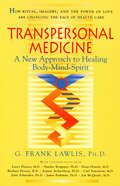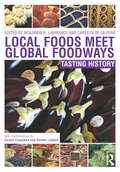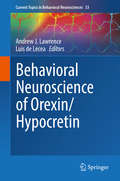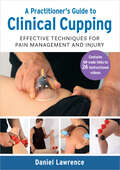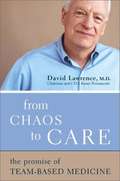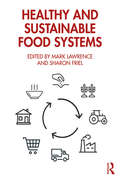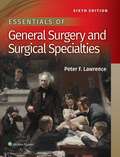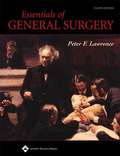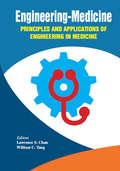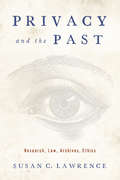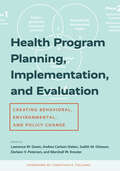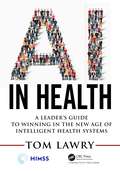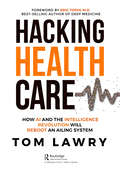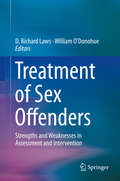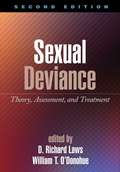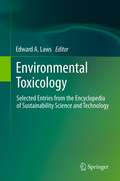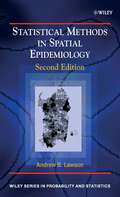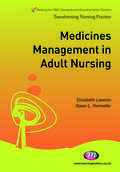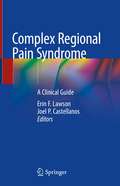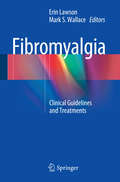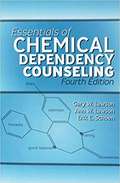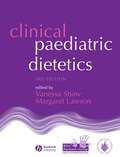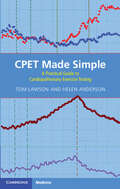- Table View
- List View
Transpersonal Medicine: The New Approach To Healing Body-mind-spirit
by G. Frank LawlisTranspersonal Medicine chronicles the pioneering efforts to apply a transpersonal orientation to the field of medicine. Broken into three parts, it reviews the underlying principles of transpersonal medicine. Part one focuses on ritual as a means of cross-personal empowerment. Part two is devoted to the personal ritual, the process of empowering one's inner strengths and wisdoms. Part three is dedicated to direct experiences and issues involved in medicine. The book includes interviews with leading researchers in each field of topics.
Local Foods Meet Global Foodways: Tasting History
by Benjamin N. Lawrance Carolyn de la PeñaThis book explores the intersection of food and foodways from global and local perspectives. The collection contributes to interdisciplinary debates about the role and movement of commodities in the historical and contemporary world. The expert contributions collectively address a fundamental tension in the emerging scholarly terrain of food studies, namely theorizing the relationship between foodstuff production and cuisine patterns. They explore a wide variety of topics, including curry, bread, sugar, coffee, milk, pulque, Virginia ham, fast-food, obesity, and US ethnic restaurants. Local Foods Meet Global Foodways considers movements in context, and, in doing so, complicates the notions that food 'shapes' culture as it crosses borders or that culture 'adapts' foods to its neo-local or global contexts. By analysing the dynamics of contact between mobile foods and/or people and the specific cultures of consumption they provoke, these case studies reveal the process whereby local foods become global or global foods become local, to be a dynamic, co-creative development jointly facilitated by humans and nature. This volume explores a vast expanse of global regions, such as North and Central America, Europe, China, East Asia and the Pacific, India, sub-Saharan Africa, the Atlantic Ocean, and the USSR/Russia. It includes a foreword by the eminent food scholar Carole Counihan, and an afterword by noted theorist of cuisine Rachel Laudan, and will be of great interest to students and researchers of history, anthropology, geography, cultural studies and American studies. This book is based on a special issue of Food and Foodways.
Behavioral Neuroscience of Orexin/Hypocretin (Current Topics in Behavioral Neurosciences #33)
by Andrew J. Lawrence Luis De LeceaThis issue of Current Topics in Behavioral Neuroscience focuses on the neuropeptide orexin (hypocretin) and brings together scientists from around the world who will provide a timely discussion of how this peptide regulates behavior. This is a fast-moving field, and with the incorporation of novel technologies, new breakthroughs are likely to continue. For example, the use of optogenetic approaches has enabled the identification of the role of orexin-containing neurons in arousal states, critical for higher order functioning. From a clinical perspective, genetic polymorphisms in hypocretin/orexin and orexin receptors are implicated in a number of psychiatric disorders. In addition, advanced clinical trials are currently underway for orexin receptor antagonists in the treatment of insomnia and sleep disorders. We aim to capture a broad audience of basic scientists and clinicians.
Asperger Syndrome - What Teachers Need to Know
by Clare Lawrence Matt WinterAs awareness and diagnosis of Asperger Syndrome (AS) increases across the globe, it is essential that every teacher in every classroom has a familiarity with the condition and understands how best to support AS students at their school. This fully revised and expanded second edition is the ideal resource to point teachers in the right direction. Concise and instantly accessible, this book gives a clear summary of up-to-date information on Asperger Syndrome, describing the common characteristics to look out for, and offering simple strategies for adapting to the educational needs of students with AS. Packed with useful tips and practical advice, this guide answers key questions such as 'Am I qualified to teach this child?' and 'How can I help the pupil with AS to learn?' New material includes information for teaching older children and adolescents with AS, tips on what to do when problems arise, as well as suggestions for a whole-school approach to helping students with AS. This book is the perfect go-to guide for teachers, teaching assistants and those in school management who want to know more about Asperger Syndrome in the mainstream inclusive classroom.
A Practitioner's Guide to Clinical Cupping: Effective Techniques for Pain Management and Injury
by Daniel LawrenceA modern approach to the medical practice of dry cupping—to reduce inflammation and stimulate immune response; assist in myofascial release; relieve pain; and improve healing and recovery Includes links to instructional online video contentA Practitioner&’s Guide to Clinical Cupping provides a concise, practical, and easy-to-understand guide to safe and effective cupping techniques, integrating up-to-date research on physiology, neuroscience, and biomechanics.Physiotherapist Daniel Lawrence--known for his popular &“RockPods&” cupping training courses--includes all the information a new practitioner needs to get started, including a basic history of cupping and theoretical overview; how to apply and remove cups, and how long to leave them on the skin; how to use oils and creams to assist &“glide cupping&” techniques, and more. Chapters detail specific cupping practices for different parts of the body and common ailments, including:Achilles tendon and shin painKnee, hamstring, and quad painHip problemsBack and neck painCarpal tunnel and other wrist painOther common sports and overuse injuriesFeaturing full-color photos throughout to clearly illustrate techniques, and video links for more detailed visual instruction, A Practitioner&’s Guide to Clinical Cupping offers a complete and immersive learning experience.
From Chaos to Care: The Promise of Team-Based Medicine
by David LawrenceFrom the Chairman Emeritus of Kaiser Permanente, a manifesto for integrated health care.
Healthy and Sustainable Food Systems
by Mark Lawrence Sharon FrielThis comprehensive text provides the latest research on key concepts, principles and practices for promoting healthy and sustainable food systems. There are increasing concerns about the impact of food systems on environmental sustainability and, in turn, the impact of environmental sustainability on the capacity of food systems to protect food and nutrition security into the future. The contributors to this book are leading researchers in the causes of and solutions to these challenges. As international experts in their fields, they provide in-depth analyses of the issues and evidence-informed recommendations for future policies and practices. Starting with an overview of ideas about health, sustainability and equity in relation to food systems, Healthy and Sustainable Food Systems examines what constitutes a food system, with chapters on production, manufacturing, distribution and retail, among others. The text explores health and sustainable diets, looking at issues such as overconsumption and waste. The book ends with discussions about the politics, policy, personal behaviours and advocacy behind creating healthy and sustainable food systems. With a food systems approach to health and sustainability identified as a priority area for public health, this text introduces core knowledge for students, academics, practitioners and policy-makers from a range of disciplines including food and nutrition sciences, dietetics, public health, public policy, medicine, health science and environmental science.
Essentials of General Surgery and Surgical Specialties: Textbook And The Essentials Of Surgical Specialties
by Peter F. LawrencePublisher's Note: Products purchased from 3rd Party sellers are not guaranteed by the Publisher for quality, authenticity, or access to any online entitlements included with the product. Now combining general surgery and the specialties in one volume, this Sixth Edition of Essentials of General Surgery and Surgical Specialties focuses on the information all medical students need to know to pass the NBME surgery shelf or other surgery rotation examinations. This new edition of Lawrence’s popular text offers concise, high-yield content and a smaller format ideal for study on the go. Updated to reflect the latest advances in the field, it provides the authoritative, up-to-date content today’s busy medical students need for exam success.
Essentials of General Surgery (Fourth Edition)
by Peter F. Lawrence Richard M. Bell Merril T. Dayton Mohammed I. AhmedEssentials of General Surgery, Fourth Edition is extensively revised with an abundance of new tables and illustrations, to provide the most current and up-to-date information on general surgery. The book covers the most need-to-know information about specific diseases and areas of surgery and meets all the guidelines of the Association of Surgical Educators. Additional features include an atlas of images, multiple-choice questions, and case studies.
Engineering-Medicine: Principles and Applications of Engineering in Medicine
by Lawrence S. Chan and William C. TangThis transformative textbook, first of its kind to incorporate engineering principles into medical education and practice, will be a useful tool for physicians, medical students, biomedical engineers, biomedical engineering students, and healthcare executives. The central approach of the proposed textbook is to provide principles of engineering as applied to medicine and guide the medical students and physicians in achieving the goal of solving medical problems by engineering principles and methodologies. For the medical students and physicians, this proposed textbook will train them to “think like an engineer and act as a physician”. The textbook contains a variety of teaching techniques including class lectures, small group discussions, group projects, and individual projects, with the goals of not just helping students and professionals to understand the principles and methods of engineering, but also guiding students and professionals to develop real-life solutions. For the biomedical engineers and biomedical engineering students, this proposed textbook will give them a large framework and global perspective of how engineering principles could positively impact real-life medicine. To the healthcare executives, the goal of this book is to provide them general guidance and specific examples of applying engineering principles in implementing solution-oriented methodology to their healthcare enterprises. Overall goals of this book are to help improve the overall quality and efficiency of healthcare delivery and outcomes.
Privacy and the Past: Research, Law, Archives, Ethics
by Susan C. LawrenceWhen the new HIPAA privacy rules regarding the release of health information took effect, medical historians suddenly faced a raft of new ethical and legal challenges--even in cases where their subjects had died years, or even a century, earlier. In Privacy and the Past, medical historian Susan C. Lawrence explores the impact of these new privacy rules, offering insight into what historians should do when they research, write about, and name real people in their work. Lawrence offers a wide-ranging and informative discussion of the many issues involved. She highlights the key points in research ethics that can affect historians, including their ethical obligations to their research subjects, both living and dead, and she reviews the range of federal laws that protect various kinds of information. The book discusses how the courts have dealt with privacy in contexts relevant to historians, including a case in which a historian was actually sued for a privacy violation. Lawrence also questions who gets to decide what is revealed and what is kept hidden in decades-old records, and she examines the privacy issues that archivists consider when acquiring records and allowing researchers to use them. She looks at how demands to maintain individual privacy both protect and erase the identities of people whose stories make up the historical record, discussing decisions that historians have made to conceal identities that they believed needed to be protected. Finally, she encourages historians to vigorously resist any expansion of regulatory language that extends privacy protections to the dead. Engagingly written and powerfully argued, Privacy and the Past is an important first step in preventing privacy regulations from affecting the historical record and the ways that historians write history.
Health Program Planning, Implementation, and Evaluation: Creating Behavioral, Environmental, and Policy Change
by Lawrence W. Green, Andrea Carlson Gielen, Judith M. Ottoson Darleen V. Peterson and Marshall W. KreuterA time-tested, landmark approach to health promotion and communication projects and everything that goes into making them successful.For more than 40 years, the PRECEDE-PROCEED model, developed in the early 1970s by Lawrence W. Green and first published as a text in 1980 with Marshall W. Kreuter, Sigrid G. Deeds, and Kay B. Partridge, has been effectively applied worldwide to address a broad range of health issues: risk factors like tobacco and lack of exercise, social determinants of health such as lack of access to transportation and safe housing, and major disease challenges like heart disease and guinea worm disease. In Health Program Planning, Implementation, and Evaluation, Green and his team of senior editors and chapter authors combine their expertise to offer a high-level guide to public health programming. This guide aligns with foundational public health competencies required by increasingly rigorous certification and accreditation standards. Driven by the coronavirus pandemic and a looming climate crisis, the book addresses the rapid changes in modern-day conceptions of disease prevention and health promotion.Today's public health practitioners and researchers are often called upon to address a complex web of factors, including population inequities, that influence health status, from biology to social and structural determinants. Program and policy solutions to population health challenges require systematic planning, implementation, and evaluation. Providing students with knowledge, skills, and a range of tools, the book recognizes new approaches to communication and fresh methods for reaching a greater diversity of communities.The authors highlight the importance of starting the population health planning process with an inclusive assessment of the social needs and quality-of-life concerns of the community. They explain how to assess health problems systematically in epidemiological terms and address the behavioral and environmental determinants of the most important and changeable health problems. They also cover procedures for assessing and developing the capacity of communities and organizations to implement and evaluate programs. Drawing on more than 1,200 published applications of the PRECEDE-PROCEED model, Health Program Planning, Implementation, and Evaluation features numerous case studies and contributions from internationally recognized experts, including governmental, academic, and community public health leaders, giving readers a thorough and well-rounded view of the subject. Ultimately, it is an up-to-date powerhouse for community and global health promotion at all levels. Contributors: Faten Ben Abdelaziz, John P. Allegrante, Patricia Chalela, Cam Escoffery, Maria E. Fernandez, Jonathan E. Fielding, Robert S. Gold, Shelly Golden, Holly Hunt, Vanya C. Jones, Michelle C. Kegler, Gerjo Kok, Lloyd J. Kolbe, Chris Y. Lovato, Rodney Lyn, Guy Parcel, Janey C. Peterson, Nico Pronk, Amelie G. Ramirez, Paul Terry
AI in Health: A Leader’s Guide to Winning in the New Age of Intelligent Health Systems (HIMSS Book Series)
by Tom LawryWe are in the early stages of the next big platform shift in healthcare computing. Fueled by Artificial Intelligence (AI) and the Cloud, this shift is already transforming the way health and medical services are provided. As the industry transitions from static digital repositories to intelligent systems, there will be winners and losers in the race to innovate and automate the provision of services. Critical to success will be the role leaders play in shaping the use of AI to be less "artificial" and more "intelligent" in support of improving processes to deliver care and keep people healthy and productive across all care settings. This book defines key technical, process, people, and ethical issues that need to be understood and addressed in successfully planning and executing an enterprise-wide AI plan. It provides clinical and business leaders with a framework for moving organizations from the aspiration to execution of intelligent systems to improve clinical, operational, and financial performance.
Hacking Healthcare: How AI and the Intelligence Revolution Will Reboot an Ailing System
by Tom LawryIn this original work, Tom Lawry takes readers on a journey of understanding what we learned from fighting a global pandemic and how to apply these learnings to solve healthcare's other big challenges. This book is about empowering clinicians and consumers alike to take control of what is important to them by harnessing the power of AI and the Intelligent Health Revolution to create a sustainable system that focuses on keeping all citizens healthy while caring for them when they are not.
Treatment of Sex Offenders
by D. Richard Laws William O'DonohueThis rigorous survey offers a comprehensive rethinking of the assessment and treatment of sexual offenders for a bold challenge to practitioners. It critiques what we understand about offenders and the mechanisms of offending behaviors, and examines how this knowledge can best be used to reduce offending and relapses. To this end, experts weigh the efficacy of common assessment methods and interventions, the value of prevention programs, and the validity of the DSM's classifications of paraphilias. This strengths/weaknesses approach gives professional readers a guide to the current state as well as the future of research, practice, and policy affecting this complex and controversial field. Included in the coverage: Strengths of actuarial risk assessment. Risk formulation: the new frontier in risk assessment and management. Dynamic risk factors and offender rehabilitation: a comparison of the Good Lives Model and the Risk-Need-Responsivity Model. The best intentions: flaws in sexually violent predator laws. Desistance from crime: toward an integrated conceptualization for intervention. From a victim/offender duality to a public health perspective. A call to clear thought and accurate action, Treatment of Sex Offenders will generate discussion and interest among forensic psychologists, psychiatrists, clinical psychologists, and social workers.
Sexual Deviance, Second Edition
by D. Richard Laws William T. O'DonohueNow in a fully revised and updated second edition, this important work provides authoritative scientific and applied perspectives on the full range of paraphilias and other sexual behavior problems. For each major clinical syndrome, a chapter on psychopathology and theory is followed by a chapter on assessment and treatment. Challenges in working with sex offenders are considered in depth. Thoroughly rewritten to reflect a decade of advances in the field, the second edition features many new chapters and new authors. New topics include an integrated etiological model, sexual deviance across the lifespan, Internet offenders, multiple paraphilias, neurobiological processes, the clinician as expert witness, and public health approaches.
Environmental Toxicology
by Edward A. LawsEnvironmental Toxicology provides a detailed, comprehensive introduction to this key area of sustainability and public health research. The broad coverage includes sections on ecological risk assessment, monitoring, mechanisms, fate and transport, prevention, and correctives, as well as treatment of the health effects of solar radiation and toxicology in the ocean. The 23 state-of-the-art chapters provide a multi-disciplinary perspective on this vital area, which encompasses environmental science, biology, chemistry, and public health.
Statistical Methods in Spatial Epidemiology
by Andrew B. LawsonSpatial epidemiology is the description and analysis of the geographical distribution of disease. It is more important now than ever, with modern threats such as bio-terrorism making such analysis even more complex. This second edition of Statistical Methods in Spatial Epidemiology is updated and expanded to offer a complete coverage of the analysis and application of spatial statistical methods. The book is divided into two main sections: Part 1 introduces basic definitions and terminology, along with map construction and some basic models. This is expanded upon in Part II by applying this knowledge to the fundamental problems within spatial epidemiology, such as disease mapping, ecological analysis, disease clustering, bio-terrorism, space-time analysis, surveillance and infectious disease modelling. Provides a comprehensive overview of the main statistical methods used in spatial epidemiology.Updated to include a new emphasis on bio-terrorism and disease surveillance.Emphasizes the importance of space-time modelling and outlines the practical application of the method.Discusses the wide range of software available for analyzing spatial data, including WinBUGS, SaTScan and R, and features an accompanying website hosting related software.Contains numerous data sets, each representing a different approach to the analysis, and provides an insight into various modelling techniques.This text is primarily aimed at medical statisticians, researchers and practitioners from public health and epidemiology. It is also suitable for postgraduate students of statistics and epidemiology, as well professionals working in government agencies.
Medicines Management in Adult Nursing (Transforming Nursing Practice Series)
by Elizabeth Lawson Dawn L HenneferCorrect medicines management for adults is a crucial skill that adult nursing students must develop in order to provide safe care to their patients. This book specifically supports pre-registration students in meeting the required competencies for medicines management needed to pass formal assessment and qualify as an adult nurse. It is clearly structured around the NMC Essential Skills Clusters for medicines management, covering legal aspects, drugs calculations, administration, storage, record keeping, introductory pharmacology, patient communication and contextual issues in medication. The book is written in user-friendly language and uses patient scenarios to explain concepts and apply theory to practice.
Complex Regional Pain Syndrome: A Clinical Guide
by Erin F. Lawson Joel P. CastellanosThis book provides an up-to date, extensive, and focused review of complex regional pain syndrome (CRPS). It reflects the current scientific understanding of the disorder, describes appropriate treatment recommendations, and explores future directions of diagnosis and treatment. Divided into three sections, the first section covers the etiology and pathology of CRPS. The following section offers treatments and emerging advances in evaluation and/or treatment. The book then closes with an exploration of varying patient populations. Each chapter is authored by specialists experienced with CRPS research and treatment. Additionally, the review and recommendations provided reflect careful consideration of evidence-based medicine and medical consensus guidelines. Complex Regional Pain Syndrome targets a range of healthcare specialties including pain management, rheumatology, neurology, internal medicine, and family practice.
Fibromyalgia
by Erin Lawson Mark S. WallaceThis practical text provides a clinical overview of the etiology, diagnosis and treatment for fibromyalgia. Current evidence-based treatments and guidelines are emphasized along with lifestyle modification suggestions for the patient. Also included is a review of current literature, research and emerging developments on this prevalent pain syndrome. A range of healthcare specialties, including pain management, rheumatology, neurology, internal medicine and family practice, will find this comprehensive guide to be a valuable resource to their routine treatment of fibromyalgia and improve patient's quality of life.
Essentials of Chemical Dependency Counseling
by Gary Lawson Ann W. Lawson Erik E. SchoenThe fourth edition of this well-known, evidenced-based text presents new ways of thinking about and addressing problems related to chemical dependency treatment and prevention. Essentials of Chemical Dependency Counseling explores the full range of issues that face today's counselors and counselors-in-training. Three new chapters include help for aspiring counselors trying to negotiate the complex path of certification and licensure, an in-depth look at different types of psychopharmacology, and a review of evidenced-based practices for treating substance use disorders. Other updates include assessing readiness to change, couples counseling and chemical dependency, other addictions, uniting harm reduction and traditional treatment, and relapse prevention. <P><P>The use of chapter objectives and discussion questions and the availability of an e-book instructor's manual make this an ideal textbook for use in chemical dependency counseling courses in programs of psychology, family therapy, and social work.
Clinical Paediatric Dietetics
by Margaret Lawson Vanessa ShawThis standard work has been comprehensively revised and expanded to meet the needs of the modern practising and student dietitian.In tune with current trends, a greater emphasis has been placed on public health issues such as the treatment of childhood nutritional disorders in the community, including obesity and faltering growth. The book now also contains a dedicated chapter on the important issue of allergy prevention.* Edited by leading experts at Great Ormond Street and the Institute of Child Health* Officially supported by the British Dietetic Association* Written for dietitians, by dietitiansWith worked examples of dietary management given throughout, Clinical Paediatric Dietetics is an indispensable guide for all those involved in the nutritional treatment of children.
CPET Made Simple: A Practical Guide to Cardiopulmonary Exercise Testing
by null Tom Lawson null Helen AndersonCardiopulmonary exercise testing (CPET) is an increasingly important investigation for anaesthesiologists, surgeons, cardiologists, pulmonologists, physiologists, and peri-operative physicians. For trainees, non-experts, or simply those seeking an introduction to interpreting CPETs, this essential book builds layers of knowledge that can be applied in case studies and in future practice. It will help you learn and understand: • What is CPET and what are the principles of exercise physiology • How to conduct a CPET • How to interpret a CPET nine-panel plot • How to assess exercise capacity and limitation. This practical and clinical guide is both easy to read and easy to understand and features diagrams illustrating key principles. It outlines the basic physiological principles and takes a step-by-step approach to conducting and interpreting a cardiopulmonary exercise test, together with case studies to consolidate learning. Chapters cover the indications and contraindications of CPET, test safety and complications, spirometry, writing a CPET report, and shared decision-making.
Guérir les douleurs émotionnelles et physiques grâce au pouvoir de la méditation
by Pauline LawsonAimeriez-vous pouvoir éliminer les malaises, les inflammations, les reflux, la dépression, l'anxiété et la douleur ? Depuis très longtemps, la guérison naturelle par les techniques de méditation est utilisée pour traiter un certain nombre de maux ! L'utilisation des techniques de guérison naturelle par la méditation vous aidera également à traiter les maladies chroniques, les inflammations, votre système immunitaire, vos niveaux d'énergie, votre concentration, votre bonheur général, et bien plus encore ! Ressentez des émotions plus positives. Découvrez les secrets que les professionnels de la guérison naturelle utilisent pour se sentir en meilleure santé que jamais ! Avec des décennies de stratégies testées, cet ebook vous montrera la manière la plus rapide et la plus efficace d'utiliser la méditation au profit de votre bien-être ! Vous apprendrez comment augmenter votre bien-être en seulement quelques semaines. Non seulement cela, mais vous améliorerez littéralement tous les aspects de votre vie. Vous voulez savoir comment les gens gèrent les maladies chroniques et les troubles physiques et mentaux ? Vous aussi, vous pouvez apprendre les secrets pour y parvenir, ce qui vous permettra d'être plus heureux et en meilleure santé. Ce guide vous enseigne des techniques éprouvées sans avoir recours à des suppléments ou à des cours coûteux. Ce qui est inclus : - Remèdes. - Combattez le stress. - Avoir plus d'énergie. - Dormez mieux. - La pleine conscience. - Surmonter les maux. - La nutrition. - Ce que vous devez savoir. + BEAUCOUP PLUS ! Si vous voulez être en meilleure santé, guérir des maux, ou améliorer la concentration et le bien-être, alors ce guide est pour vous. --> Faites défiler vers le haut de la page et cliquez sur ajouter au panier pour acheter instantanément Avertisse
